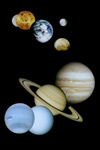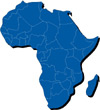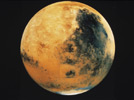7th-8th Grade
The Sky Tonight (Live)
 The Sky
Tonight is a full-length live tour of the night sky for the time of your visit. Students
will learn the secrets to finding objects in the
current sky, including the visible planets, constellations, some deep sky objects,
and the Moon. We will also discuss some of the myths and
legends associated with the celestial objects.
The Sky
Tonight is a full-length live tour of the night sky for the time of your visit. Students
will learn the secrets to finding objects in the
current sky, including the visible planets, constellations, some deep sky objects,
and the Moon. We will also discuss some of the myths and
legends associated with the celestial objects.
Crashlanding Louie (Taped)
Join the alien Louie on his journey through our solar system. His ship develops a problem and he must search our solar system for somewhere safe to land. He finds the Earth and, after some study, decides it’s his best bet. He crashes on Earth and while waiting for rescue he learns all about the Earth and everything he can see on it. He’ll need every piece of information about the sun and moon and how they move to guide his rescue party to him in safety. Will they make it? Visit the Ritter Planetarium to see Crashlanding Louie and find out.
Bear Tales (& Other Grizzly Stories) (Taped)
Bear Tales, produced by Joe Hopkins Engineering Productions, takes us on a family camping trip out to the dark skies of the forest. Grandpa Ben tells tall tails about the night sky, including Greek and Egyptian mythologies. This program introduces the constellations of the spring sky. It also demonstrates the different views one gets with binoculars, telescopes, or just the human eyes. Bear Tales gets your students involved with generous doses of humor and a sing-a-long. Get program follow-up activities (pdf).
So, You Want to Be an Astronomer...? (Taped)
So, You Want to be an Astronomer...? is a Ritter Planetarium production that takes a look at backyard astronomy and examines what astronomers do and how they do it. It also looks at career options in astronomy. The program is any student's perfect introduction to the night sky, amateur astronomy, and the life of astronomers.
Native American Skylore (Taped)
Native American Skylore is a look at the nighttime sky, the seasons, the phases of the Moon, and the motions of the planet Venus as seen through the eyes of Native Americans. Included are such topics as Serpent Mound, Native American myths and legends, and how ancient records are still useful to astronomers today.
Journey Through the Solar System (Live)
 Journey
Through the Solar System, (JTS), is an entirely new and updated version of our classic school program. It begins
with a live sky talk and
then moves on to an examination of the Sun and a tour of the nine planets and their
major satellites. Our current version of JTS includes some of
the most recent images available from the latest space expeditions. The program also
examines the minor members of our Solar System: comets,
asteroids, and meteors. Get program follow-up activities (pdf).
Journey
Through the Solar System, (JTS), is an entirely new and updated version of our classic school program. It begins
with a live sky talk and
then moves on to an examination of the Sun and a tour of the nine planets and their
major satellites. Our current version of JTS includes some of
the most recent images available from the latest space expeditions. The program also
examines the minor members of our Solar System: comets,
asteroids, and meteors. Get program follow-up activities (pdf).
Lifestyles of the Stars (Taped)
Lifestyles of the Stars is produced by Bowen Productions. In this program we join a tour group, climb aboard a celestial tour bus, and visit some of the biggest, brightest, and hottest stars in the universe. This fun, exciting, and educational program discusses how stars are born, live out their lives, and finally die. The program also includes a live sky talk.
The Stargazer (Taped)
The Stargazer, an exciting program produced by the Great Lakes Planetarium Association, explores how imagination, curiosity, & scientific thought have allowed us to begin to understand some of the deepest mysteries of the universe. The Stargazer is narrated by Nichelle Nichols, "Star Trek’s" Lt. Uhura. While she journeyed to the stars in TV and movies, in this planetarium program she shows us how we can "visit" the stars with telescopes and our minds.
Ancient Worlds (Live)
Ancient Worlds looks at the barren, rocky worlds of the Solar System: Mercury and our Moon. This program looks at the evolution of these worlds, and also at comets and meteors as clues to the early solar system. The program also discusses the birth of our star, the Sun. While Ancient Worlds can be customized to any age, it is strongly recommended that students be previously exposed to Journey Through the Solar System or its equivalent.
The Weather Out There (Taped)
Weall know how difficult the weather can be. But did you ever wonder what causes it? In this program, your group will learn why we have weather on the Earth and what the weather would be like if we lived on other planets. Bring your group to experience twisters here on the Earth, dust storms on Mars, and acid rain on Venus!
Skywatchers of Africa (Taped)
 Since the beginning of human
experience, the people of Africa have used their knowledge of the sky to meet their
physical needs for survival, and for navigation. They have
used the sky as a guide to build their societies, and for calendar making. The sky
also shapes their spiritual lives; playing an important role
in many ceremonies and providing clues to the deepest human questions. Skywatchers of Africa, produced by the Adler Planetarium,
examines several cultures, past and present, from across the African continent. It
shows how these examples are similar to the experience of
people all around the world.
Since the beginning of human
experience, the people of Africa have used their knowledge of the sky to meet their
physical needs for survival, and for navigation. They have
used the sky as a guide to build their societies, and for calendar making. The sky
also shapes their spiritual lives; playing an important role
in many ceremonies and providing clues to the deepest human questions. Skywatchers of Africa, produced by the Adler Planetarium,
examines several cultures, past and present, from across the African continent. It
shows how these examples are similar to the experience of
people all around the world.
Jovian Worlds (Live)
Jovian Worlds examines the four massive gaseous planets of our Solar System: Jupiter, Saturn, Uranus, and Neptune. This program discusses these worlds, their satellites, and their rings. It also contains the latest information on Pluto and the possibility of trans-Plutonian worlds. Once again, we strongly recommend that students be previously exposed to Journey Through the Solar System, or its equivalent, to gain the maximum potential benefit from this program.
Celestial Motions (Live)
Celestial Motions fully utilizes the capabilities of the central star projector. Your students will be introduced to the daily, annual, and precessional motions of the Earth; the reasons why we have seasons and eclipses; and why the Moon (and some of the planets!) go through phases. The unique environment of the planetarium is virtually essential in teaching these concepts. We strongly advise that all students be exposed to this program, or a similar one, at least twice during their academic careers. Get program follow-up activities (pdf).
The Dawn of Astronomy (Taped)
 Journey
back in time to discover why the pyramids of Egypt and Stonehenge in England were
built. Your students will see the splendor of the newly raised
pyramids and watch as the Sun rises over the Heel Stone at Stonehenge. The incredible
achievements of early man in measuring the length of the
year, developing a concept of the Zodiac, and predicting exactly how the Sun and Moon
move in the sky are celebrated in The Dawn of Astronomy.
Journey
back in time to discover why the pyramids of Egypt and Stonehenge in England were
built. Your students will see the splendor of the newly raised
pyramids and watch as the Sun rises over the Heel Stone at Stonehenge. The incredible
achievements of early man in measuring the length of the
year, developing a concept of the Zodiac, and predicting exactly how the Sun and Moon
move in the sky are celebrated in The Dawn of Astronomy.
Navigating with Lewis & Clark (Taped)
How did Lewis and Clark know where they were when they were in the middle of nowhere? Find out when you see this new planetarium program. You’ll learn how Lewis and Clark used the positions of the Sun and other celestial objects to estimate where they were. And you’ll see how you can do it, too.
Serpents of the Sun (Taped)
Produced by the Ward Beecher Planetarium and the Boonshoft Museum of Discovery in Dayton, Ohio, Serpents of the Sun examines the rich cultures and astronomical heritages of several Native American civilizations that made Ohio their homes. This program examines several burial mounds in central and southern Ohio and SunWatch, a Native American Stonehenge, located near Dayton, Ohio.
Where Have all the Martians Gone??
 For over a hundred years, we have
been pondering about whether or not there is life on Mars. Our recently updated program,
Where Have all the Martians Gone??, examines
our ever-changing understanding of the "red planet," and whether or not it has --
or ever had -- life on it. This program also looks at the
recent discoveries made by the Mars Global Surveyor, and outlines our planned missions
to Mars, the most intriguing of all the planets.
For over a hundred years, we have
been pondering about whether or not there is life on Mars. Our recently updated program,
Where Have all the Martians Gone??, examines
our ever-changing understanding of the "red planet," and whether or not it has --
or ever had -- life on it. This program also looks at the
recent discoveries made by the Mars Global Surveyor, and outlines our planned missions
to Mars, the most intriguing of all the planets.
The Lives & Deaths of Stars (Live)
The Lives & Deaths of Stars introduces stellar evolution and the origin of the elements from which we are made. It is exciting to think that the carbon in our bodies was once inside a star, and came to us through a stupendous supernova explosion. This program also covers the sizes and colors of the stars.
See how these programs meet Science Education Standards.


